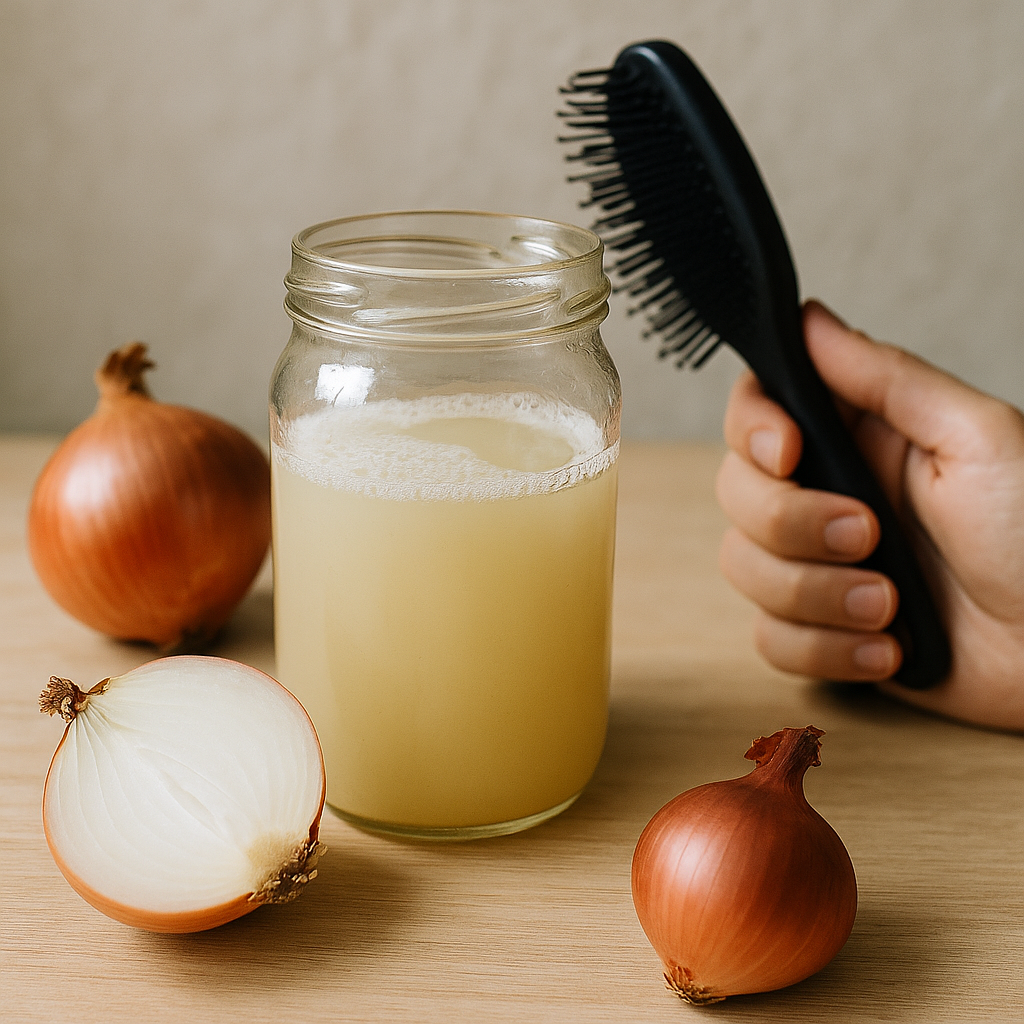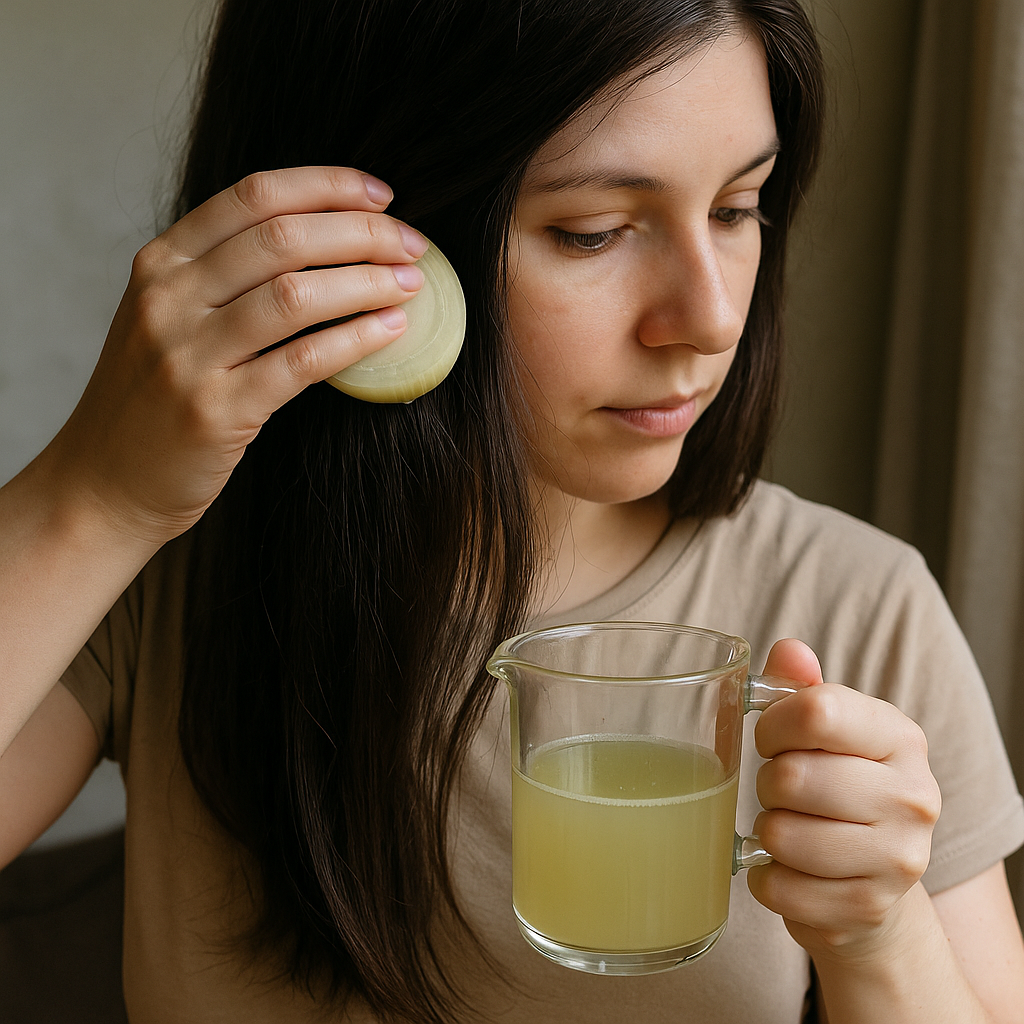Ask Ayurvedic doctor a question and get a consultation online on the problem of your concern in a free or paid mode. More than 2,000 experienced doctors work and wait for your questions on our site and help users to solve their health problems every day.
Shop Now in Our Store
How to Make Onion Juice for Hair? Benefits, Storage, and Application Tips

Ever wondered if that pungent kitchen staple—onion—could be the secret to your dream hair? Turns out, it just might be. In this guide, we’re diving into everything you need to know about how to make onion juice for hair, why it's making waves in haircare routines, and how to actually use it without smelling like a salad. From how to use onion juice for hair to onion juice for hair fall issues, we’ve got you covered. Whether you're dealing with thinning strands or just curious about natural remedies, this article spills all the secrets (and juice) you need to know.
So, grab an apron (and maybe some nose plugs) because we're about to chop, blend, and apply our way to healthier hair.
Benefits of Onion Juice for Hair Fall and Hair Loss
Before we dive into how to make onion juice for hair, let’s talk about why you’d even want to.
Onions are rich in sulfur—a compound that plays a big role in the production of keratin, the protein that your hair is mostly made of. Applying onion juice for hair stimulates blood circulation to the scalp, nourishes hair follicles, and reduces inflammation. That’s a pretty powerful combo when it comes to battling hair fall and hair loss.
Some of the benefits of onion juice for hair include:
-
Strengthening hair strands and preventing breakage
-
Stimulating new growth, especially in patchy areas
-
Reducing dandruff thanks to its antibacterial properties
-
Improving shine and texture over time
It’s not a miracle cure, let’s be honest—but consistent use can absolutely make a noticeable difference. And hey, it’s way cheaper than those fancy salon treatments.

How to Make Onion Juice for Hair at Home
Okay, let’s get into the good stuff: the DIY. Learning how to prepare onion juice for hair is pretty simple, and once you’ve done it a couple times, it becomes a breeze.
Ingredients and Tools Needed
Here’s what you’ll need:
-
2 to 3 medium-sized red onions (they have the most sulfur)
-
Blender or grater
-
Cheesecloth or a fine strainer
-
Bowl
-
Airtight container (if you’re storing it)
Optional:
-
A few drops of essential oil (like lavender or tea tree) to mask the smell
Step-by-Step Preparation Guide
-
Peel and chop the onions into chunks. No need to be precise—just make them blendable.
-
Blend or grate the pieces until you get a thick, pulpy mix. If using a blender, add just a little water to help it along.
-
Strain the pulp using a cheesecloth or fine sieve into a clean bowl. Squeeze out every last drop like your hair depends on it. (Because it kinda does.)
-
(Optional) Add a few drops of your chosen essential oil. This step doesn’t affect effectiveness but helps a LOT with the smell.
-
Transfer the juice into an airtight bottle or jar. You're ready to roll!
Now you know how to make onion juice for hair growth right in your kitchen—no need for any fancy ingredients or expensive products.

How to Apply Onion Juice on Hair and Scalp
Now that you’ve got your DIY onion juice ready, here’s how to apply onion juice on hair without turning your bathroom into an allium-scented disaster zone.
-
Start with dry hair: It absorbs better that way.
-
Use a cotton ball or applicator bottle to dab or spray the juice onto your scalp. Focus on the roots, where hair growth happens.
-
Massage gently using your fingertips for 5–10 minutes. This boosts blood circulation and helps the juice soak in.
-
Leave it on for 30 minutes to 1 hour. (Yes, you can watch an episode of something in the meantime.)
-
Wash thoroughly with a mild shampoo. You might need to lather twice to get the smell out.
Do this 2–3 times a week for best results. Daily application? That might be a bit much—and the scent could be a social risk.
How to Use Onion Juice for Hair Growth Effectively
Knowing how to make onion juice for hair is just step one. Using it right? That’s where the real magic happens.
If you're aiming for maximum results (and minimum stink), here's what you need to know about how to use onion juice for hair growth:
1. Be consistent—but not obsessive
Two to three times a week is the sweet spot. Using onion juice for hair more frequently might irritate the scalp or dry it out. On the flip side, using it once a month won’t cut it. Like most natural remedies, consistency is key.
2. Combine with other ingredients
You don’t have to go solo. Mix your onion juice with other hair-loving ingredients:
-
Castor oil for thicker hair
-
Aloe vera gel for scalp soothing
-
Coconut oil to help with dryness
-
Honey (yup) for hydration and shine
These blends not only boost results but also mellow the smell, which—let’s be real—can be kind of intense.
3. Do a patch test first
Not everyone’s scalp reacts the same. Some people might experience itching, redness, or even a mild burning sensation. Before you go full-head, dab a bit on your inner arm and wait 24 hours. Better safe than scratching your scalp off later.
4. Alternate with other treatments
If you're already using a prescribed hair treatment or oil, alternate them. Don't overload your scalp with too many products all at once. It’s like layering perfumes—it never ends well.
5. Track your progress
Take weekly photos to see real changes. Trust me, it’s hard to notice new growth when you’re staring at your head every day. But over time, you might just spot new baby hairs coming through. And that’s a win.
Can We Store Onion Juice for Hair? Tips and Shelf Life
You’ve made a whole batch. Great. But now you’re wondering: can we store onion juice for hair? Because the smell of blended onion lingering in your fridge isn’t the dream.
The good news: yes, you can store it.
How Many Days Can You Store It and How?
Freshly prepared onion juice for hair is always best, but realistically, who has time to blend onions every other day?
Here’s what to do:
-
Refrigerate in an airtight container: Preferably glass. This keeps the juice from oxidizing too fast and avoids absorbing fridge odors (because, ew).
-
Use within 3 to 5 days: After that, it starts to break down and lose its potency. Plus, the smell goes from “pungent” to “why-is-my-house-like-this.”
Pro tip: if you want to keep it longer, freeze it in ice cube trays. Just pop out a cube or two the night before use. Simple and effective. But don’t re-freeze after thawing. That’s where things get sketchy.
One thing to note—over time, even stored properly, the sulfur compounds degrade. So if you're wondering how many days we can store onion juice for hair, stick to under a week max for the best results. Beyond that, you’re probably just rubbing funk on your scalp.
Also! Label it clearly. You do not want to accidentally mix it up with your smoothie prep.
Conclusion
So there you have it. From how to make onion juice for hair, to application, to storage—we’ve covered the entire stinky (but effective) journey. Whether you’re struggling with hair fall, trying to boost thickness, or just looking for a natural fix, onion juice is a surprisingly powerful tool that’s been used for centuries.
It’s not always pretty. The smell? Kinda brutal. The prep? A bit messy. But the payoff? Healthier, stronger hair that grows back thicker over time. And hey, for something sitting in your kitchen right now, that’s a pretty solid return on investment.
Give it a go, be patient, and don’t forget to breathe through your mouth.
FAQs
Q: Does onion juice really help hair?
Short answer: Yes, for many people. While there isn’t a ton of large-scale scientific research, several small studies and tons of anecdotal evidence suggest that onion juice for hair growth can stimulate follicles and improve blood circulation. Plus, the sulfur and antioxidants help reduce inflammation and support hair strength.
Of course, it's not magic. If you have underlying conditions like hormonal imbalances or alopecia, it might not work as well—or at all. Still, for mild hair fall or early-stage hair loss, it’s definitely worth trying.
Q: How to boil onions for hair growth?
So here’s the deal: raw onion juice has the strongest sulfur content. But if the smell is too much—or your scalp reacts to the raw stuff—you can try boiled onion water instead.
Here’s how:
-
Chop 2–3 onions roughly.
-
Boil them in 2 cups of water for 10–15 minutes.
-
Let it cool, then strain the water into a bottle.
Use it as a hair rinse after shampooing or apply it like regular onion juice. It’s milder (smell-wise and strength-wise), so don’t expect exactly the same results, but it’s a decent alternative for sensitive folks.
Q: Can I apply onion juice to my hair daily?
Technically, yes—but should you? Not really.
Daily application can dry out your scalp or cause irritation for some people. A good routine is 2 to 3 times a week. If your scalp starts to itch or flake, dial it back. It’s not a “more is better” situation.
Also, you probably don’t want to walk around smelling like a sandwich topping every day, do you?
Final Thoughts: Give Your Hair Some (Onion) Love
At this point, you should have a solid understanding of how to make onion juice for hair, how to use it, and how to store it without fumigating your entire house. It’s one of those weird-but-effective beauty hacks that’s stood the test of time. The benefits of onion juice for hair are real—stronger strands, stimulated growth, and potentially even reversed thinning when used right.
Of course, not everyone will love the smell or the prep. And that’s fine. Natural remedies aren’t for everyone, and results vary. But for those who stick with it, onion juice can be a game-changer.
A few quick reminders before you run to your kitchen:
-
Start slow, test it on your skin first.
-
Be consistent—miracles don’t happen overnight.
-
Don’t overdo it—your scalp will thank you.
-
And don’t forget to refrigerate or freeze your juice if you’ve made a batch.
Who knew something as basic as an onion could unlock so many haircare possibilities?
This article is checked by the current qualified Dr Sujal Patil and can be considered a reliable source of information for users of the site.

